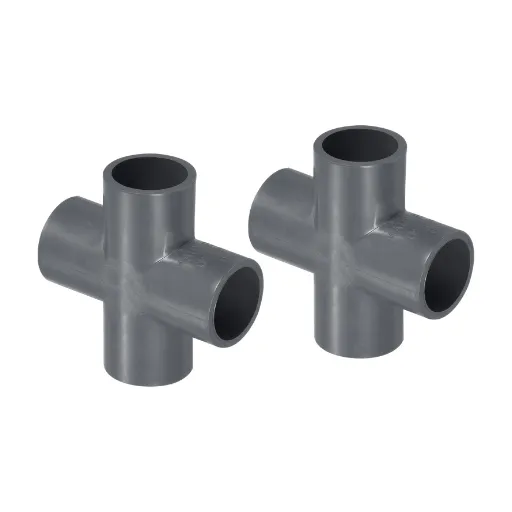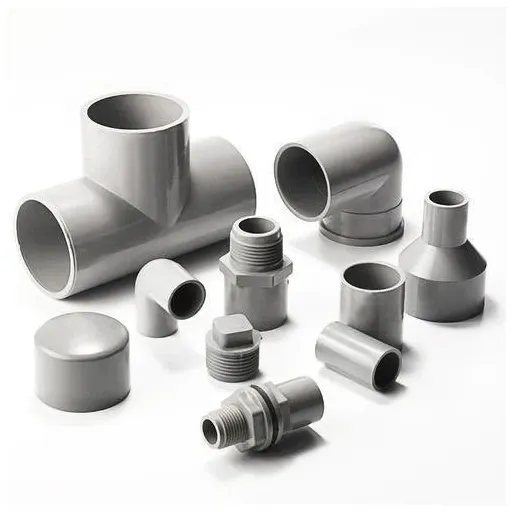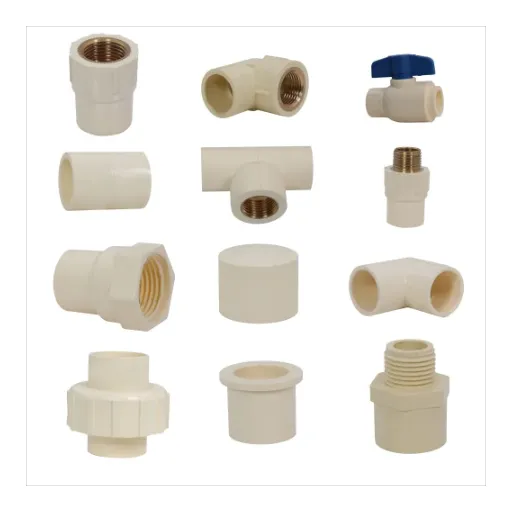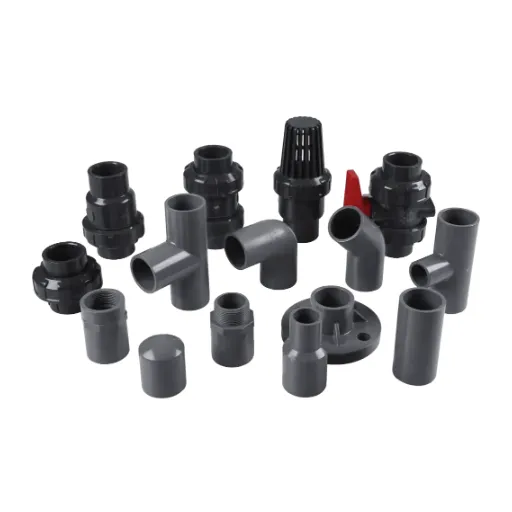When it comes to construction, plumbing, or DIY activities, selecting the proper pipe fitting is important so as to guarantee durability and high efficacy. Among the many options for pipe fittings available, Schedule 40 gray PVC pipe fittings continue to hold a prime position for their versatility, strength, and cost-effectiveness. So, what really sets these fittings apart, and why would one consider them as an answer to a great big project? In this write-up, we shall focus on all that needs to be known about Schedule 40 gray PVC pipe fittings-from their unique features and properties, to the applications used commonly. The guide will assist you, whether you are a seasoned pro or a newbie doing it for the first time, to recognize how these fittings could cater to your project needs. Keep with the article as we break down the must-knows and guide you to making the right choices for your projects.
Introduction to PVC Pipe Fittings

What Are PVC Pipe Fittings?
PVC pipe fittings are used for connecting or joining different sections of PVC pipe or for redirecting or terminating these sections. Said to be valued for being lightweight, durable, and resisting corrosion and damage due to chemicals, these are necessary to produce leak-proof welding joints in plumbing systems, irrigation, and other piping systems.
They come in different sizes and shapes for uniting the different piping needs. Some of the well-known types are elbows, tees, couplers, and adapters. Elbows allow the pipe line direction to change; tees allow for the branching of flow paths; couplers join two pipes together, and adapters allow the pipes to connect to other materials or systems. This variety essentially allows PVC fittings to be prepared for any configuration from the simplest to the most complex, be it in residential, commercial, or industrial projects.
Versatility and ease of installation of PVC fittings are ranked as the primary advantages. They can just simply be glued or cemented in a solvent; therefore, they are quite manageable by even laymen. In addition, having a cheap price and long-life performance witness for their application in anything from house plumbing down to the whole industrial system.
Importance of Schedule 40 in Plumbing
Schedule 40 represents a typical plumber’s trade standard thickness of PVC pipe. The term implies a fairly consistent wall thickness that can tolerate modest pressure and temperature conditions and is hence considered a standard choice in many plumbing applications. Its longevity and versatility do weigh much in favor for its importance in residential and commercial-level plumbing systems, as well as industrial-grade installations.
One of the greatest advantages of using Schedule 40 PVC is that it is cheap and readily available. It will carry regular house water pressures, thus not hampering the process of water flow through the plumbing system. Furthermore, Schedule 40 pipes can resist corrosion, adverse chemicals, and the elements; hence, it is practically ideal for application both outdoors and indoors.
Like all standard PVC pipes, Schedule 40 is very easy to work with in that it can be cut and glued together using all simple tools. It is so lightweight that it is easily transported and installed, saving time and labor for professionals and DIYers. All in all, Schedule 40 has a great presence in plumbing for providing the correct solution cheaply and for lots of different applications.
Common Uses of Gray PVC Pipe
Since it is non-conductive and can resist adverse weather, the gray PVC pipe is most often used in electrical conduit systems. The gray type provides safe housing for electrical wires, keeping the wires dry and free from sunlight and physical damage. Due to its high durability and strength, it can stand both residential and commercial electrical applications.
Another use of the gray PVC pipe lies in irrigation systems. Since it withstands pressure and corrosion, the pipe provides dependable water transport, making it an indispensable element in landscape irrigation and agricultural watering setups. UV resistant, it also can function effectively in outdoor environments exposed to prolonged sunlight.
Industrial use finds gray PVC pipe for chemical and fluid transport. Its chemical resistance and lightweight design enable easy installation and maintenance while guaranteeing durability in complicated systems. Hence, its versatility and reliability make it a commendable fit for all of its utility and industrial purposes.
Benefits of Using PVC Pipe in Your Projects

Durability and Resistance to Corrosion
PVC pipe finds acclaim especially for its durability and corrosion resistance. Metal pipes rust with time, whereas the life span of PVC pipe gets reduced by chemical corrosions and even weather changes. Thus, it finds use in industries prone to applications involving water chemicals or harsh soils. Its non-reactive surface cannot allow the impact of chemical reaction on it; thereby, it holds its structural strength and longevity even in severe conditions.
The ability to resist environmental stresses can be termed as the second advantage with PVC piping. It can bear severe temperature variations; thus, it is suitable for all climatic conditions whether hot or cold. Being resistant to UV rays further enhances the lifetime of easy PVC long exposure to sunlight. In contrast, other materials would deteriorate very fast when exposed to similar conditions. On the other hand, PVC pipes present a smooth interior surface that helps minimize frictional losses to sustain efficient fluid flow over time.
Because the maintenance requirements for PVC piping are minimal, long-term costs for businesses and homeowners are also lowered. It is resistant to corrosion, meaning it does not require costly protective coatings or frequent replacement when they deteriorate. Being lightweight, PVC allows for straightforward transportation and installation, which again reduces labor and logistical costs. Together, these attributes make PVC an affordable, dependable, and sustainable option for nearly any application-from the plumbing needs of a home to massive industrial systems.
Cost-Effectiveness of PVC Materials
Alongside almost any other construction and manufacturing material, PVC (polyvinyl chloride) is also referred to as a very low-priced material on account of its long life and barely considered maintenance requirements. Because PVC costs less in production when set alongside common materials such as wood, metals, and concretes, it stands as an attractive option. The decreased initial cost of PVC is in fact enormously advantageous to sectors looking for cost savings, brought about by less expensive raw materials and manufacturing techniques with efficient energy consumption. Even the very high longevity of this material could minimize replacement frequency; hence this is a key saver in the longer run.
Energy efficiency and recyclability are key factors making PVC cheap. PVC requires less energy in production than many other materials, which reduces the cost of production and finally the environmental impact. Plus, PVC materials can usually be recycled into new products and so can bring down waste disposal costs while supporting the circular economy. This facet of sustainability comes in handy for the company, while it also aligns the company with worldwide and industry-level environmental responsibility goals. It is reported that recycled PVC saves about 80% of the energy required to make virgin material, thus being the cheapest way both economically and environmentally.
The adaptability of PVC only goes to enhance its economic appeal further. Being lightweight, it diminishes the cost of transportation, meaning more of it can be shipped at a time, whereas lesser amounts of PVC require transportation and installation in large projects. Besides, resistance to corrosion, weathering, and chemical attack of PVC eliminates maintenance costs, making it an ongoing investment for either the residential or industrial type of installation. Its versatility and cheapness make it a go-to material in plumbing systems, window frames, or even medical devices. Together, these characteristics emphasize that PVC firmly remains a viable alternative in an increasingly resource-conscious world, both practically and financially.
Ease of Installation and Maintenance
Another biggie in the PVC’s bag of virtues is the ease of installation, which makes construction and assembly easier to carry out in many projects. PVC materials are lightweight, which helps reduce the physical load on workers during transportation and installation. Also, making them interlocking or fitted with standard fittings, PVC components such as pipes or window frames ensure they are easily fitted together with minimum tools. This flexibility ensures efficient installation even for large-scale industrial or residential applications.
This longevity nature of PVC thus opened up the long view for maintenance considerations. Resistance to weathering, corrosion, and chemical degradation allows PVC to give ample performance in varying environments-that is, environmental factors such as extreme temperatures, moisture, or any form of industrial chemicals. Further, most PVC surfaces tend to be smooth and non-porous, barring dirt deposits into it and thereby helping in easy cleaning and upkeep. At this highest level of durability, it would reduce the total life costs, making PVC an attractive alternative on an economic basis for different application options.
If we put PVC on the scale with metals and wood, time saved in installations and maintenance will weigh above them. Metal structures commonly need a type of specialized equipment to be able to weld or to secure individual pieces of metals with one another, making the whole process harder and costly. Wood, although very versatile, needs treatments regularly for keeping it safe against rot, pests, or structural actual degradation. In comparison, PVC stands right between being cheap, easy to install, and almost free from maintenance, meeting present-day requirements of time and sustainability. It is this very combination that has kept PVC in the premier league of practical, economical choices.
Installation Tips for PVC Pipe Fittings
Tools Required for Installation
The tools for installing a PVC pipe fitting have to be certain to make a secure and efficient setup. The listed tools are commonly used:
- PVC Pipe Cutter or Hacksaw: For clean and precise cuts on PVC pipes. A fine-toothed saw or a specialized pipe cutter would avoid rough edges.
- Measuring Tape: The measuring tool that makes perfect measurement for pipes would be incorrect in case the pipes are loosely fitted or do not meet with one another.
- Deburring Tool or Sandpaper: Edges are to be smoothed and burr removed after cutting to fit well and seal.
- Solvent Cement and Primer: These adhesives and primers are employed for PVC to bond the fitting securely, hence reliably in high-pressure systems.
- Cleaning Cloths: These cloths are used for cleaning the surfaces of the pipes before they are joined, which aims at preventing leaks and promoting good adhesion.
- Marker or Pencil: For marking the cut-offs or intended aligning positions during installation.
- Gloves and Safety Glasses: For protection of the hands and eyes while cutting and applying of adhesive.
Having them handy would make the installation go faster and simultaneously ensure safety and optimum performance for the PVC piping system. Having everything prepared and making fair use of the tools will somehow lessen installation errors.
Step-by-Step Guide to Fitting PVC Pipes
- 1
Measure and Plan: Begin by measuring the length of PVC pipe you require for your project. Here, use a tape measure and give precise measures so that nothing goes to waste. Mark the cutting points well with a marker or pencil for more accuracy. It is very much essential to lay down the plan of the layout that will include all the fittings and connections before any cutting or assembling is undertaken. - 2
Cut the PVC Pipe: After marking the lengths of the PVC pipes to be cut, use a hacksaw or PVC pipe cutter to cut accordingly. Always be sure that you have made your cuts clean and straight; these two go a long way in ensuring that your fittings will best adhere to them. After the cutting, ensure you file or sand down the edges of the pipe so as to eliminate any burrs or rough surfaces that might prevent your connection. - 3
Dry Fit the Components: Dry fit all PVC pipe, fittings, and valves to be certain of proper alignment and fit. Dry fitting allows you to make any corrections to assure that the entire system is properly aligned and meets your design specifications. - 4
Apply Primer: If you are satisfied with the dry fit, take apart the parts and apply primer to the outside of the pipe ends and to the inside of the fitting. The primer cleans and softens the surfaces to ensure a better bond when the glue is applied. - 5
Adhesive Application: After priming, immediately apply a thin, even layer of PVC adhesive over both the pipe and fitting surfaces that were just primed. Work fast; the adhesive dries quickly. Too much adhesive can make a mess and goes against cementing. - 6
Joining and Holding: Push the pipe firmly into the fitting with a bit of twisting to evenly distribute the adhesive and hold for 15-30 seconds to let the bond set. Wipe off any excess adhesive. - 7
Curing Process: Allow the adhesive to cure according to the manufacturer’s instructions after all the connections have been completed. Usually, the curing process takes 24 hours for the bond to be ready for use. The system must not be tested before the curing process to prevent leaks or weak joints. - 8
Testing for leaks: Clean the joints using solvent cleaner if leaks are found, heat-align them and try these all again to be sure. When all joints have finished setting, run water through the pipes and check all joints for leaks. Should any leak be detected, disassemble and clean them, then apply solvent cement again on the joints involved.
Taking these steps will ensure that your PVC piping installation will be considered reliable and safe. Always check the manufacturer’s instructions for any specific directions for the materials you use to ensure maximum safety and efficiency.
Common Mistakes to Avoid
- Skipping Surface Preparation: Improper cleaning and priming of pipe surfaces may lead to weak bonds and leaks. Check to see if the surfaces are dirty or greasy or have any debris before applying adhesive.
- Wrong Adhesive: Selecting the wrong PVC cement or primer will weaken the strength of your joints and will compromise its integrity. Adhesives shall always be matched to the pipe specifications and intended use.
- Rushing the Cure: Pressurizing the system before full cure of the adhesive is one of the frequent causes of failure. Always adhere to manufacturers’ guidelines on curing time to fully set the connections.
- Over-Tightening Fittings: Where fittings are threaded, excessive tightening may cause cracking. Always hand-tighten first, followed by using tools if necessary; however, excess force should be never applied.
- Ignoring Testing of the System: Sometimes issues may arise unnoticed and increase over time if a proper leak test has not been conducted after installation. Always test the system with water before completing the installation.
By avoiding these common mistakes and by paying attention to recommended practices, one will have a durable and efficient PVC piping system for sorting.
Common Applications of PVC Pipe Fittings

Residential Plumbing Projects
PVC pipe fittings are dependable and versatile for routing several systems around a house. Drainage and supply systems and irrigation accept PVC fittings due to their inexpensive prices, light weight, and resistance to corrosion. Installation must be done quickly to allow the PVC pipe to be chosen and with confidence for the durability of the finish.
When designing a plumbing system for homes, PVC pipe fittings allow one to tailor designs to his layout and requirement. Water heaters connect, and potable water is distributed throughout the house efficiently, adaptable enough to work well and avoid leakage from the system. Moreover, with recent developments in material technologies and adaptation to the standard, PVC fittings nowadays are capable of withstanding water pressures and temperatures better than before.
When integrated fittingly with planning and system testing as stated earlier, permanent solutions that assure the continuous and safe supply of water can be given to homeowners and professionals. An acceptable installation followed by maintenance ensures the durability of these systems for many years.
Industrial Uses and Applications
PVC fittings are widely gaining acceptance in various industries because of their durability, economic utility, and adaptability to diverse working conditions. Below are five major industrial applications of PVC fittings:
Water Treatment Plants
Due to its corrosion resistance and capacity to work with both high-pressure and low-pressure water systems, PVC fittings are extensively employed in the water treatment plants. They aid in transferring clean water and in efficient ways of handling wastewater.
Chemical Processing
The chemical industry makes extensive use of PVC fittings to transport corrosive liquids and gases. Their resistance to chemical reactions makes these fittings a safer and reliable form of operation under critical processes.
Agricultural Irrigation Systems
PVC fittings are used in contemporary agriculture, including drip and spray irrigation. Being light in weight and withstanding abrasion, they guarantee water delivery and consequent conservation of water.
Oil and Gas Industry
They are put to use in oil and gas operations for managing secondary non-flammable fluids. Since they are cost-effective and could also withstand varying temperatures, they are chosen for such secondary systems in this industry.
HVAC Systems
Heating, ventilation, and air-conditioning systems use PVC fittings for their ductworks and drainage. These systems take advantage of the insulation property of the material and the strength-to-weight ratio for energy efficiency and longevity.
The above-described activities demonstrate the versatility and importance of PVC fittings across diverse industries and highlight the contribution of this product toward better operating and sustainable systems.
Outdoor and Garden Uses of PVC Pipe
PVC pipes are truly something versatile and are used for various applications in outdoor and garden settings. For my part, I use PVC pipes to build a really simple system that irrigates my garden. Bringing together pipes, sprinkler heads, and valves, one can put together a great watering system that ensures that all plants get adequate watering, especially during intense summer heat. Since PVC is durable and withstands weather conditions perfectly, it is also an excellent product to use for long-term garden solutions.
Another application where I make use of PVC pipes is making garden structures that are fully customizable and lightweight. It’s also perfect for constructing trellises, supports for plants, and even protective frames for beds. These can be sized to the exact requirements of any garden layout and can be either quickly put together or taken apart. Their low price also makes trying out different designs economically viable.
For the final one, PVC pipes are good for outdoor tool and space organization. I build PVC storage racks for garden tools so everything can remain neatly arranged and within easy reach. One can even engage in interesting DIY projects with them-simple greenhouse construction or garden decorations. Being cheap and versatile, PVC pipes always remain my primary choice for almost all outdoor and gardening applications.
Recent Trends in PVC Pipe Fittings

Innovations in PVC Materials and Designs
One main development is enhancement of eco-friendly PVC formulations designed to replace harmful additives like lead and phthalates, using instead non-toxic stabilizers from renewable sources.
New technology is also being developed in extrusion processes to provide stronger flexibilities in PVC pipes, allowing the use of thinner walls that are still very durable. There are advantages with this innovation because one can save on materials without compromising performance. In addition, corrugated structures and multi-layer designs are being developed to bear loads better and conversely improve thermal insulation.
With the growing demand for smart infrastructure, PVC pipes are now embedded with sensors for the real-time monitoring of water flow and pressure, especially in urban water systems. Special coatings resistant to UV rays and superior joint designs guarantee top efficiency, durability, and reliability throughout all applications-from agriculture to construction.
Thus, even with advancements, PVC represents a highly versatile material, fulfilling the requirements of the present-day sustainability agenda and adapting to the functional demands of several industries.
Environmental Impact and Sustainability Efforts
There have been discussions about PVC’s environmental impact and attempts to make the industry more sustainable. One recent move has been increasing the use of recycled material in production, thereby creating less need for virgin resources and also reducing overall energy used. At the same time, companies in the PVC industry are opting for renewable energy providers, reducing carbon emissions as a result. These days, these measures are in the forefront of greener orientation in the PVC industry.
My take on the topic is that the life cycle of PVC is very significant when it comes to sustainability considerations. Since it is highly durable and recyclable, the replacement of PVC is seldom necessary, thereby diminishing the waste generated. Now with advanced techniques of recycling such as chemical and mechanical, more PVC is collected from used articles and reprocessed into usable raw material. This saves resources and reduces landfill build-up.
Moving forward, the realm of innovation clearly strives toward making PVC ever more sustainable. Research is underway for developing alternatives that are bio-based as opposed to traditional chemical additives, which basically reduces the use of fossil fuels. Furthermore, education and collaboration among the industry are being exercised to pursue the development of sustainable practices. These endeavors find support under the larger goal of balancing functionality with environmental stewardship.
Future of PVC Pipe in Plumbing and Construction
The future of PVC pipes in plumbing and construction is closely tied with technology advancements and an orientation towards sustainability. Elevated by newly introduced production techniques, PVC pipes are being made more resistant to environmental and climatic stresses, thereby strengthening their position as a preferred material in civil works. Another outcome of these advancements in material science is lightweight yet strong variants that cut down transportation and erection cost without compromising on function.
Procurement in sustainability terms is becoming more significant for the construction industry with which PVC pipes are in tune. Technologies embedding recycled PVC into new loop cycles are lessening the generation of waste while fulfilling the highest form of quality needed for plumbing and construction applications. Also considered here are measures that enhance the recyclability effect of the product at the very end of its life cycle, thus cementing PVC’s place as a greener option.
Being pvc pipe with multiple versatility functional ability for varying applications, it is used in potable water systems and also in drainage and sewage systems. The corrosion resistant nature of PVC gives a long-term cost benefit, and the adaptation of such an essential material with the evolving smart plumbing systems keeps it relevant to an anyhow fast-growing industry. This factor assures an optimistic and sustained future for PVC pipes in construction and plumbing.
References
-
University of Minnesota – Septic Systems
- Pipe materials: PVC fittings and joints for mechanically strong installations
This source relates the essential aspects of the installation of PVC piping, including joints and fittings.
- Pipe materials: PVC fittings and joints for mechanically strong installations
-
University of Minnesota – Septic Systems
- Pipe materials: Joining PVC pipe without glue
It discusses the different ways of joining PVC pipes, including gluing.
- Pipe materials: Joining PVC pipe without glue
-
Kellogg Community College – Research Guide
- PVC Pipe – Industrial Pipefitting, Plumbing, & Steam
A source for students in plumbing and pipefitting concerning PVC pipe applications.
- PVC Pipe – Industrial Pipefitting, Plumbing, & Steam
- Click here to read more.
Frequently Asked Questions (FAQ)
Q: What are the uses of PVC pipe fittings?
A: PVC pipe fittings generally stand in plumbing for joining various sections of PVC pipes to transport water, waste, and vent gases in the most efficient manner. They are simply the perfect option offered for drainage and vent systems, be it for residential-use or for commercial applications.
Q: What are PVC pipe fittings for?
A: The PVC pipe fittings include elbows, tees, couplings, adapters, and caps, just to name a few. This hardware comes in a wide range of diameters suitable to various pipe sizes, so you can be sure these fittings will work with your current plumbing setup.
Q: Are PVC pipe fittings suitable for drain and waste systems?
A: Yes, PVC pipe fittings are suited for drain, waste, and vent (DWV) systems, considering their durability and resistance to corrosion. They thus become the preferred choice for plumbing applications, where they get involved in wastewater flows and venting of gases.
Q: Can I use PVC pipe fittings for hose connections?
A: PVC pipe fittings are usually for use with rigid piping systems, but with an adaptation accounting for the hose, they can also be put to use. Make sure that the fittings match the diameter of the hose for a most secure fit.
Q: What are benefits of seamless PVC pipe fittings?
A: Seamless PVC pipe fittings provide several advantages, including increased strength and integrity. They do not have seams, which can often be a point of leakage, and can withstand higher pressures; thus, they are well suited for plumbing and drainage system applications.
Q: What is one way to determine what size PVC pipe fitting will work?
A: To check for the correct size of PVC pipe fitting, measure the outside diameter of the pipes. The fittings should always be that size so as to guarantee a tight fit and no leakage in the piping arrangement.
Q: Are there any special considerations for installing PVC pipe fittings?
A: Installing PVC pipe fittings requires ensuring that all surfaces are clean and free from dust or paint. Apply PVC cement on both mating surfaces and let it dry properly before testing it. Also, remember the peculiarities involved in drain and vent applications, so they are done per plumbing code.
Q: What is the environmental impact of using PVC pipe fittings?
A: PVC pipe and fittings are generally considered durable and long-lasting, so that they need not be replaced that often. However, PVC products must surely be recycled at the end of their useful life to minimize environmental impacts. Many manufacturers do have programs to accommodate correct such recycling of PVC materials.
Conclusion
Schedule 40 gray PVC pipe fittings offer an excellent balance of durability, cost-effectiveness, and versatility for a wide range of plumbing and construction projects. By understanding their properties, proper installation techniques, and best practices, you can ensure successful project outcomes that stand the test of time. Whether you’re working on residential plumbing, industrial applications, or outdoor projects, PVC pipe fittings provide reliable solutions that meet both performance and budget requirements.






